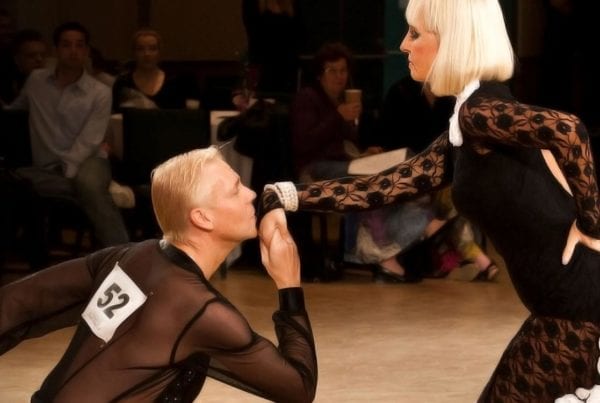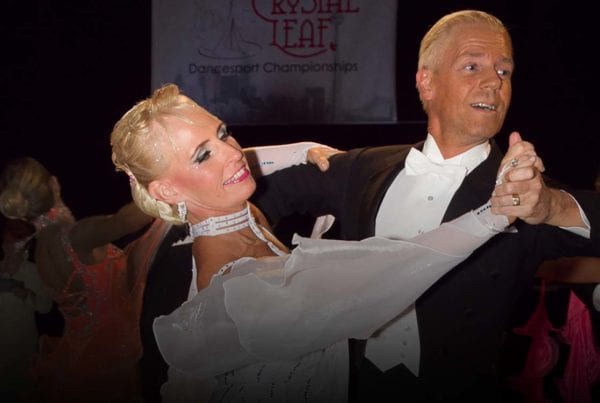The Samba is a sexy, lively Latin American dance from Brazil. The music is fun and exciting. The International-style Samba that has been formalized into ballroom dancing is not exactly the same as the authentic Samba you'll find in Brazilian social dancing settings, but that doesn't diminish the excitement of this dance.
Delta Dance presents a complete Intermediate Samba routine. This is the exact same program we teach in our dynamic live group classes. A comprehensive two-hour program, your lessons are broken down into different parts to make it easier for you to learn. Within each video you'll find chapter markers to let you jump directly to a specific step pattern.
The steps we cover in this routine are the same ones taught in the technical manuals used by dance teachers around the world. No matter where you travel in the world, dancers will be familiar with these patterns.
Samba is one of the more difficult Latin dances. This is primarily because it uses a total of eight different rhythms. For example, 1a2a3a4, or 1a2 3a4, or Slow Quick Quick, and so on. Some figures are even more challenging, with awkward 3/4 1/2 3/4 timing that is exceptionally difficult to master. For this routine we have picked the most common step patterns, and most of these utilize the 1a2 timing to simplify the learning process.
Normally we don't recommend routines for learning a dance. Instead, we focus on "groups" of step patterns. The reason is that when people learn a routine they quickly fall into a pattern where they only dance the routine the same way every time, which is not only boring but limits your ability to improvise and explore everything ballroom dancing represents. However, because so many aspects of Samba require a depth of understanding of lead and follow technique, we want you to be able to dance around the room and not waste years of your life getting to a place where you can just dance. So for this dance we have created a routine.
The routine takes you all the way around the dance floor, ending right at the very beginning where you started. We show you places where you can join up to earlier places in the routine in case you are uncomfortable with parts further along in the routine. That way you can learn comfortably in stages.
Throughout the video, we cover common issues that we see in teaching and in watching social dancers, providing useful insights to help you dance a more technically accurate and enjoyable Samba.
This video is available to all Delta Dance members.
Eight Samba Rhythms
Samba uses 2/4 timing, which means there are two beats to a musical "bar" or measure. Although we count in groups of 8 beats because the music is phrased that way, Samba officially counts as 12 12 12 12 etc rather than 12 34 56 78. However, we generally teach using the 8 counts as it's easier for people to relate to. There are eight different Samba rhythms. Individual step patterns use one of these rhythms.
- 1a2 This refers to one beat, 1/4 beat and 3/4 beat. Note that "a" in dance musicality always refers to 1/4 beat.
- 12 This consists of two single beats and is counted as Slow Slow.
- 1a2a1a2 This timing uses 3/4, 1/4, 3/4, 1/4, 3/4, 1/4 and finally a whole beat.
- 123 This unusual timing uses 3/4 beat, then 1/2 beat, then 3/4 beat. It can be difficult to master. In this routine, it's used in the Rolling Off the Arm.
- SQQ This timing is measured as one beat, then half, half. It is often counted as 12and (the word "and" in dance musicality refers to 1/2 beat).
- SQQQQQQ This timing uses one beat, then a series of half beat counts.
- QQS Counted as 1and2, this timing consists of two half beats then a whole beat.
- SSQQS Counted as one beat, one beat, 1/2, 1/2 and one beat or 121and2.
Video Demonstration
This video shows the complete routine so that you can see how it moves around the floor, and so that you can identify where the different figures take place in relation to a typical size floor. George and Wendy are dancing it in a social style, similar to how social dancers might perform the dance.
Curriculum
This is a comprehensive course that totals two hours in length. We've broken it down into multiple parts to make it easy to digest and to find the individual sections that you'll want to learn.
Part 1: Samba Basics (length 38:52)
This lesson is slightly longer than the others, and that's because it covers a basic sequence that you can use to actually dance all the way around the room. This sequence is perfect if you are learning Samba for the first time. We cover the Samba Bounce and how to achieve it, then move on to Samba Basic Movement, the Whisk, the Samba Walk and Voltas.
Part 2: Samba Locks and Criss Cross Bota Fogos (length 20:32)
In this lesson you'll learn how to insert Samba Locks into the center of your Criss Cross Voltas. We then show you Bota Fogos and how to dance them in a criss-cross pattern.
Part 3: Rolling Off the Arm (length 15:58)
Rolling Off the Arm is one of the more exciting Silver figures in Samba. We show you how to set up for this figure, then proceed with two Rolling Off the Arms, each with a different ending.
Part 4: Shadow Bota Fogos and Shadow Voltas (length 4:47)
At this part of the routine, you set up to move across the short wall with a couple of Shadow Bota Fogos and Rhythm Bounces, then travel with Traveling Voltas in Shadow Position.
Part 5: The Roundabout (length 16:17)
The Roundabout can be confusing because of the Contra position of the couple, but is actually composed of simple Samba figures. This section of the routine begins with a couple of Shadow Bota Fogos, and a Contra Bota Fogo before moving on to The Roundabout. We show you a fun ending that includes Criss Cross Voltas.
NEW! Part 5b: Stationary Samba Walks (length 8:58)
When we first produced this Samba video program, we managed to miss the Stationary Samba Walks that take place right after the Roundabout. We had taken a much-needed break and when we resumed, this section was skipped. We show you the Stationary Samba Walks and a fun variation you can add using Circular Spot Voltas.
Part 6: The Maypole, Back Rocks and Plaits (length 11:30)
This section begins with Stationary Samba Walks followed by the Maypole. Then the couple begins to move down the long wall with the man traveling backwards. Gold steps here are the Back Rocks and Plaits. The sequence finishes with Voltas.
Part 7: Corner Sequence and Zig Zags (length 10:02)
Your routine continues along the second short wall with a series of fun and sexy figures. A corner sequence is composed of basic steps, then the couple moves sideways with three-point turns and Zig Zags to end at exactly the same place where the routine started, all set to begin again.

Members-Only Content
This content is available to Delta Dance members only. Membership grants you access to special content, our members-only videos, and downloadable choreography and technical guides. You may cancel at any time.
Click here to register or login below with your membership credentials.













